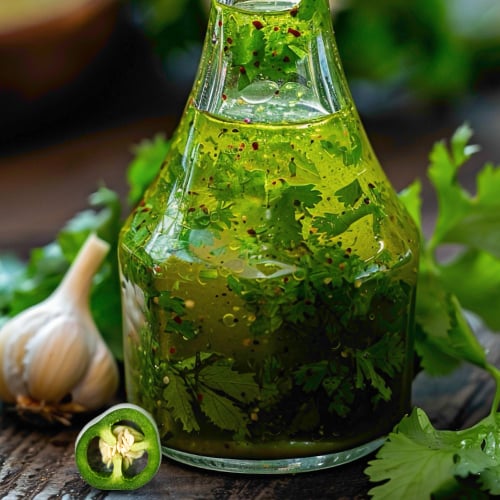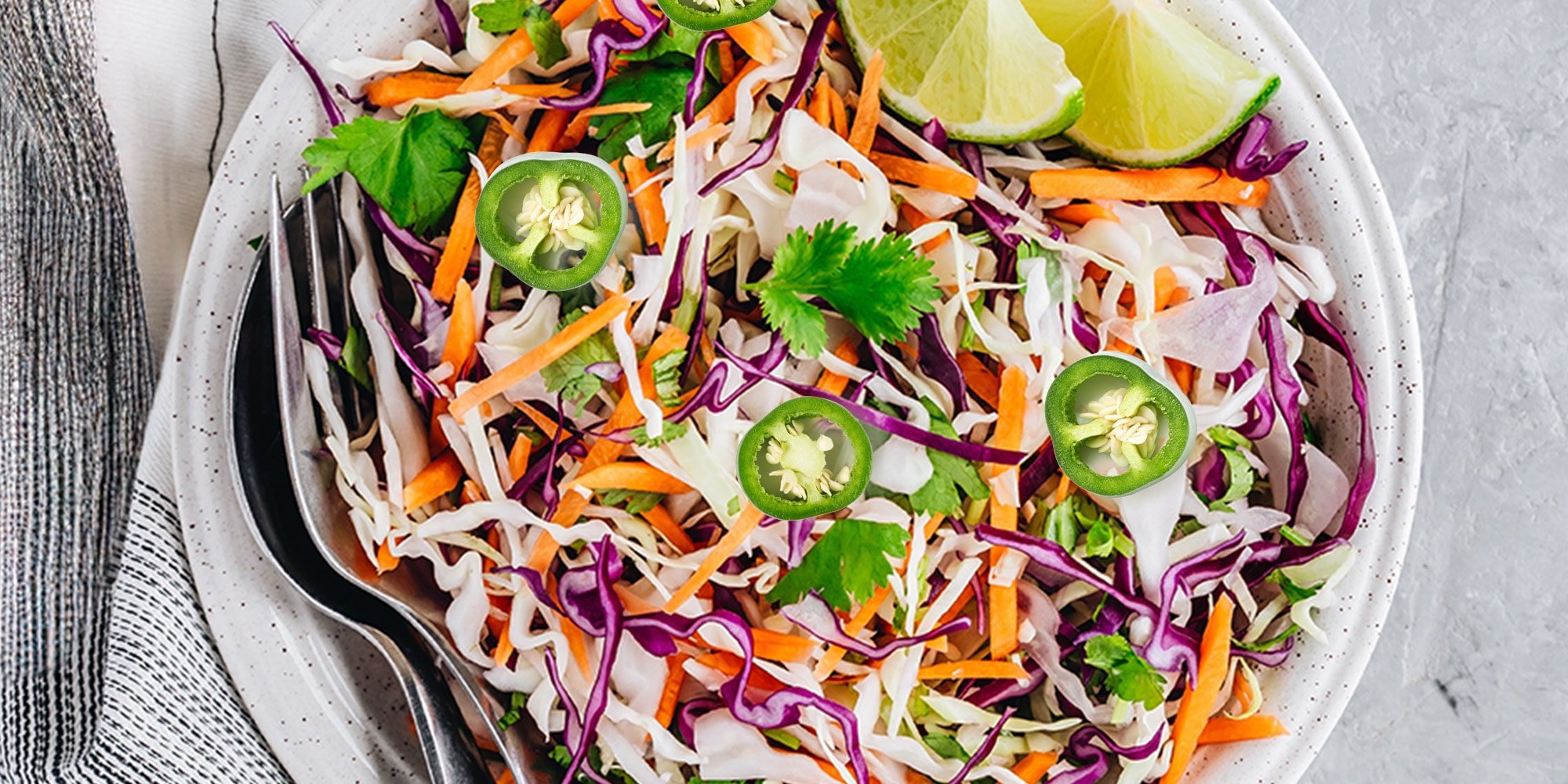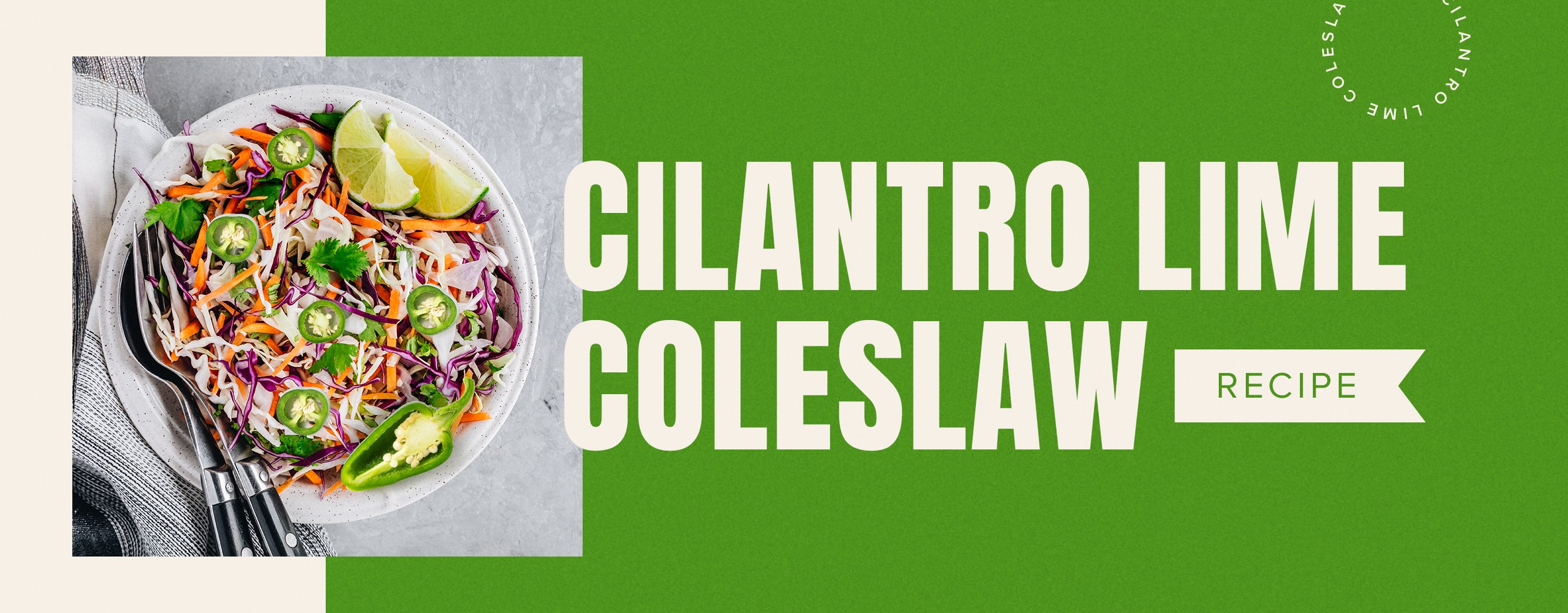Creamy coleslaw is a classic Southern side served with BBQ or stuffed into Memphis-style pulled pork sandwiches. Our cilantro lime coleslaw recipe creates a refreshing twist on this timeless classic. This tangy coleslaw adds a flavorful upgrade to traditional coleslaw. Not only does it pair great with BBQ, but it can also be substituted into our fish taco recipe and other South American-inspired meals.
Cilantro Lime Coleslaw Recipe

Our spicy coleslaw with cilantro and fresh lime juice is your new summer side dish. With just a few affordable ingredients, this easy-to-prepare recipe is easy to make for a crowd and can be sold at a high profit margin. Whether you’re planning a 4th of July catering menu or a seasonal summer menu, this cilantro lime coleslaw recipe is for you.
Yield: 8 servings
Total Time: 5 minutes
Ingredients
- 1 cup mayonnaise
- 1/4 cup Monin habanero lime syrup
- 1/3 cup finely chopped fresh cilantro
- 3 jalapeno peppers, seeded and thinly sliced
- 2 Tablespoons fresh lime juice
- 1 pound coleslaw mix
- Salt and black pepper, to taste
Directions
- Combine all ingredients except coleslaw mix. Stir until well incorporated and salt fully dissolves.
- Pour dressing over slaw mix and toss to incorporate. Season to taste with salt and pepper as needed.
- Cover and refrigerate for one hour. If desired, season slaw with more lime juice, salt, and pepper before serving.

Our fresh, flavorful cilantro lime coleslaw is perfect for caterers cooking for a crowd. Add it to your summer menu for a refreshing twist on classic coleslaw to make your dishes stand out.
Related Resources

Coriander vs Cilantro
In the culinary world, cilantro is one of the most debated herbs in the kitchen. Aside from its controversial flavor, there are questions about the difference between cilantro and coriander. Are they the same ingredient or do they serve different purposes? Those answers can vary depending on where you are in the world. We’ll clarify the difference and provide tips and tricks for using cilantro and coriander in your recipes. Shop All Herbs and Spices Is Coriander the Same as Cilantro? Coriander and cilantro are two terms that are often used interchangeably, but they actually refer to different parts of the same plant. In the U.S., coriander typically refers to the seeds of the Coriandrum sativum plant, while cilantro refers to the leaves and stems. Outside of the U.S., coriander is often used to refer to the leaves and stem while the seeds are called coriander seeds. Whether as a fresh herb or dried spice, both offer distinct flavors and are used differently in culinary dishes, making them essential ingredients in commercial kitchens. We will be using the U.S. distinction for our definitions. What Is Cilantro? Cilantro, also known as Chinese parsley, is the leafy part of the coriander plant. It belongs to the Apiaceae family and is native to regions from Southern Europe to Western Asia. The herb is characterized by its delicate, lacy leaves that resemble flat-leaf parsley but have a distinctive aroma and flavor profile. Dried cilantro is also very popular in the culinary world as a seasoning, although the fresh leaves are preferred for their vibrant color and flavor. What Does Cilantro Taste Like? Cilantro is one of those polarizing ingredients that people either love or love to hate. Cilantro is often described as having a bright, citrusy flavor with a slightly peppery undertone. Some people even detect hints of soapiness or a metallic taste in cilantro, which is actually due to a genetic predisposition that makes the herb taste unpleasant to certain individuals. What Is Cilantro Used For? Cilantro is commonly used in Mexican, Indian, Thai, and Vietnamese cuisines to enhance the taste of salsas, curries, soups, and salads. Cilantro is also a key ingredient in guacamole, giving it a vibrant and herbaceous kick. Its bright flavor profile makes it a popular choice for garnishing dishes like tacos, ceviche, and grilled meats, adding a burst of freshness to every bite. Here are some popular recipes with cilantro that you may want to add to your menu: Pico de gallo Cilantro chimichurri sauce Cilantro lime coleslaw Fish tacos Vietnamese banh mi Cilantro Substitute Whether your guests are not a fan of cilantro or you just don't have it on hand, there are several substitutes that can be used in its place. Parsley is a popular alternative that provides a similar fresh and herbaceous flavor profile. Thai basil offers a slightly different taste with hints of licorice and spice, making it a unique substitute for cilantro. Dill can also be used as a replacement, adding a fresh and slightly tangy flavor to dishes. Additionally, Mexican oregano can be a suitable substitute, providing a lime and peppery flavor profile that complements a variety of dishes. What Is Coriander? Coriander seeds, also known as cilantro seeds or dhania, are the dried seeds of the coriander plant. In many locations around the globe, the term coriander refers to the cilantro plant with its leaves and stem. Coriander is commonly used whole or ground to add depth and complexity to dishes. When used whole, they can be toasted to enhance their flavor before being added to dishes. Store them in an airtight container in a cool, dark place to maintain their flavor and freshness. Coriander seeds can be kept for up to six months, after which they may start to lose their potency. What Does Coriander Taste Like? Coriander has a warm, spicy, and slightly zesty flavor. These seeds are often described as having a complex taste profile that combines earthy, nutty, and floral notes. When used in cooking, coriander seeds can enhance both savory and sweet dishes. One of the key characteristics of coriander seeds is their aromatic quality. When crushed or ground, coriander seeds release a fragrant aroma that is reminiscent of citrus and fresh herbs. This aroma can elevate the overall sensory experience of a dish, making it more enticing and flavorful. What Is Coriander Used For? Coriander seeds have a distinct and complex taste profile that adds dimension to dishes. They are a common ingredient in spice blends, marinades, pickling recipes, and curry powders. They pair well with other spices like cumin, paprika, and garlic to create flavorful rubs and marinades. Additionally, ground coriander is frequently used in baking to add a warm, tart note to breads, pastries, and desserts. These are some recipes using coriander to delight your customers: Pickling spice blend Tandoori chicken masala Red curry paste Carrot and coriander soup Spiced basmati rice with coriander seeds Coriander Substitute When you need a substitute for coriander in your commercial kitchen, there are several options to consider. Cumin, with its warm and earthy flavor, can provide a similar aromatic profile to coriander. Fennel seeds offer a slightly sweet and licorice-like taste that can complement dishes in place of coriander. Caraway seeds, known for their slightly bitter and nutty flavor, can also be a viable substitute. Additionally, using curry powder can provide a complex blend of spices that often includes coriander, making it a convenient alternative when coriander is unavailable. Difference Between Coriander and Cilantro Coriander typically refers to the seeds of the plant, which have a warm, zesty flavor, while cilantro refers to the leaves and stems, which have a fresh, bright, and slightly citrusy taste. The seeds are commonly used in spice blends, marinades, and pickling recipes, while the leaves are perfect for salsa, salads, and garnishing dishes. Coriander and Cilantro FAQ These are some of the most commonly asked questions when it comes to cilantro and coriander: Cilantro Growing Season Cilantro thrives during the cooler months of spring and fall for its growing season. It is a fast-growing herb that prefers temperatures between 50-85 degrees Fahrenheit. Cilantro can bolt quickly in hot weather (produce seeds before its ready to be harvested), so it is best to plant it in early spring or late summer for a continuous harvest. Additionally, cilantro can be grown indoors in containers year-round, providing a fresh supply of this flavorful herb for commercial kitchens. Where to Buy Cilantro You can source fresh cilantro from local farmers' markets or grocery stores, ensuring its freshness and quality. Additionally, consider bulk purchasing from a reputable supplier to meet the demand of your kitchen. Some suppliers offer pre-cut or pre-packaged cilantro for convenient use in high-volume food preparation. Online retailers like WebstaurantStore also provide a convenient option for purchasing cilantro in larger quantities, with the added benefit of doorstep delivery for busy kitchen operations. Where to Buy Coriander Coriander seeds and powder can be readily purchased at various foodservice establishments such as wholesale stores, spice shops, and online suppliers. When buying coriander seeds, look for whole, unbroken seeds that are aromatic and have a citrusy flavor. For coriander powder, opt for a reputable brand to ensure quality and freshness. Whether you need coriander for seasoning meats, sauces, or baked goods, sourcing it from reliable suppliers is key to achieving the best flavor and quality in your commercial kitchen. Ultimately, the choice between coriander and cilantro comes down to the specific flavor profile and culinary application you are aiming for. Coriander seeds are earthy and warm, perfect for seasoning meat dishes, while cilantro leaves are bright and zesty, ideal for garnishing your signature recipes. Understanding the distinct characteristics of these herbs and spices will allow you to elevate your dishes with the right flavor notes.

Spicy Cilantro-Lime Chicken Kebabs Recipe
Kebabs are beloved around the world for their smoky meats, savory roasted vegetables, and portable design. Lime and spice marinated chicken kebabs are a smart addition to any menu, and their flavors will transport your guests to northern Africa and the Mediterranean. Whether you serve kebabs on skewers, in a pita, or on top of couscous, this exotic dish is inexpensive to make and is sure to raise your restaurant's profits. How to Make Lime and Spice Marinated Chicken Kebabs While there are a wide range of kebabs out there, we chose to make lime and spice marinated chicken shish kebabs. This recipe features traditional African and Mediterranean ingredients like yogurt, paprika, and coriander, but also incorporates herbs like cilantro and parsley that aren't often found in that part of the world. Additionally, we spiced these skewers up by replacing bell peppers with Mexican poblano chili peppers. Wondering how to cook chicken kebabs at your restaurant? Check out the video and recipe below to learn more! <iframe width="560" height="315" src="https://www.youtube.com/embed/SoahR38H8HE?rel=0" frameborder="0" allowfullscreen></iframe> Ingredients Yield: 4 kebabs 1/4 cup plain nonfat yogurt Juice from 1 lime (save zest for garnish) 1 tbsp. extra virgin olive oil 3 tbsp. chopped cilantro (save 1 tbsp. for garnish) 2 tbsp. chopped parsley 1 tbsp. minced garlic 1/2 tbsp. minced ginger 2 tsp. smoked paprika 1 tsp. ground cumin 1 tsp. ground coriander 1 tsp. kosher salt 1 tsp. black pepper 12 cherry tomatoes 1 lb. boneless skinless chicken breast cut into 1" cubes 1 yellow squash cut into 1 1/2" pieces 2 poblano peppers cut into 1 1/2" pieces Step by Step Instructions: How to Make Lime and Spice Marinated Chicken Kebabs 1.Cut the raw chicken into 1" cubes. 2.Place the chicken into a mixing bowl and add 1 tbsp. of extra virgin olive oil. 3.Add 1/4 cup of plain nonfat yogurt. 4.Squeeze the juice of one lime into the mixture. 5.Add fresh herbs. 6.Add dried spices. 7.Stir all of the ingredients in the bowl together until they're fully combined. 8.Build your skewers by alternately spearing the chicken, cherry tomatoes, squash, and peppers. 9.Place the skewers onto the grill and cook them until the chicken reaches an internal temperature of 165 degrees Fahrenheit. 10.Serve the skewers over couscous and garnish with chopped cilantro and lime zest. Cost Breakdown of Lime and Spice Marinated Chicken Kebabs TOTAL COST: $7.74 Yogurt: $0.32 Herbs and Spices: $0.58 Chicken: $1.69 Vegetables: $4.21 Couscous: $0.82 Skewers: $0.12 MENU PRICE: $17 PROFIT PER ORDER: $9.26 What Are Kebabs? Kebabs (or kabobs) are a Middle Eastern dish that's made by grilling different meats (usually chicken or lamb) on skewers over an open flame. The word "kebab" is derived from the Persian words for "grilling," "frying," and "burning," and this delicious meal is served in cuisines around the world. This dish is commonly prepared on a grill, but you can also bake kebabs in the oven. There are two main types of kebabs: shish kebabs and doner kebabs. The differences between the two are detailed below. Shish kebabs are what we traditionally think of when we hear the word "kebab," as "shish" is the Turkish word for "skewer." These can be made with a variety of meats and vegetables. Doner kebabs are also Turkish in origin and feature meat that's cooked on a vertical rotisserie. The outer layer is thinly sliced into shavings and usually served with sides or in a pita. History of Kebabs Kebabs have a long history that dates back to prehistoric times, when early humans discovered fire and began cooking meat on sticks. Ancient Greeks used skewers to prepare meat over open flames, and archaeologists have discovered crude skewers in Greece that date back to the 17th century BCE. Turkish and medieval European soldiers used their swords to grill their dinner over small fires on the battlefields. Shish kebabs were also perfect for nomadic tribes in northern Africa and the Mediterranean, as they helped tenderize gamey meat and also improved its flavor. Additionally, traders and merchants who traveled from Europe to Asia loved kebabs because they were filling and easy to prepare on the road. Whether you run a Middle Eastern bistro, food truck, or barbecue restaurant, chances are that shish kebabs are or have been on your menu. This dish is easy to prepare and perfectly portable, so it's sure to be a crowd favorite. If you don't want to use wooden skewers, you can also check out Bon Appetit's recommended metal skewer or shop all metal skewers here. No matter what you choose, lime and spice marinated chicken kebabs are a delicious meal to add to your establishment's repertoire.

What Is Tajin Seasoning?
Made from red chiles, lime zest, and sea salt, Tajin is a unique spice blend that is the perfect complement to juicy fruits, fresh vegetables, and classic cocktails. As a viral food trend sweeping across social media, Tajin seasoning is making headlines as a summer snack staple. Shop All Tajin Products. What Is Tajin? The Tajin brand was created in 1985 in Zapopan, Mexico to bottle up and commercialize the country’s most quintessential flavors: citrus and chili spice. With his grandmother’s signature chili sauce as inspiration, Horacio Fernandez brought his Mama Necha’s spice to life by combining dehydrated chilis and lime zest into what is now known as Tajin. Naturally, its influence grew rapidly across Mexican markets and Tajin is now found on spice racks in over 30 countries. This gluten-free product can be sprinkled on just about anything to add a salty, spicy, and citrusy kick to the most basic food items. How Do You Pronounce Tajin? Tajin is pronounced tah-heen and originates from the Mexican Spanish adjective that describes a relation to the Totonac; an ancient culture of Vera Cruz, Mexico. The Totonacs are believed to have built a city called “El Tajin”, which was the world’s main producer of the Vanilla plant until the middle of the 19th century. Today Tajin is synonymous with Mexican cuisine found in pantries across the world. How to Make Tajin from Scratch Follow these easy steps to create your own Tajin seaoning: Ingredients 1 cup dried chili peppers (chile de arbol, guajillo, and pasilla) 2 tsp. sea salt 1 tsp. lime zest (dehydrated) Instructions In a spice grinder blend together the chili peppers and lime zest In a bowl, combine the blended mixture and sea salt Store in an airtight container for up to 3 months What Is Tajin Used For? This versatile spice blend is the perfect addition to a wide range of food service products. Below we break down what food and beverage items that Tajin is best suited for. Tajin on Fruit The most common application for Tajin is as a flavor enhancer for juicy fruits such as mango, watermelon, and dragon fruit. The bite of citrus from the lime zest, along with the mild heat from the chilies is a beautiful contrast for sweet and succulent fruits. Sea salt is known to be hygroscopic, meaning its chemical structure is known for absorbing surrounding humidity and liquids. The addition of sea salt in this spice helps to retain the fruit juice flavor and aid in hydration. Tajin in Beverages Whether you are looking to spice up a classic bloody Mary or add a little extra flavor to your margarita’s salt rim, Tajin is a great beverage accompaniment. Here are some of our favorite cocktails and mocktails served with a Tajin twist. Michelada Ingredients 12 oz. Mexican Lager 3 oz. Tomato and Clam Juice Cocktail 1 tsp. Mexican Style Hot Sauce 1 tsp. Tajin Seasoning (in drink) 1 Tbsp. Tajin Seasoning (for salt rim) Lime Wedge Garnish Instructions Cover a dish with 1 Tbsp. of Tajin Rub the edge of a pint glass with a lime wedge and dip the rim into the Tajin to line the glass Fill the glass with ice Add Mexican lager, Clamato juice, hot sauce, and tajin into the glass and stir Garnish with a lime wedge Spiced Mule Mocktail Ingredients 4 oz. Ginger Beer 2 oz. Grapefruit Juice 1 oz. Lime Juice 1 tsp. Tajin Seasoning 1 tsp. Mexican Style Hot Sauce 4 each Mint Leaves Lime Wedge Garnish Ice Instructions Fill a rocks glass entirely with ice Add Tajin, lime juice, hot sauce and grapefruit juice and stir well Top off the drink with ginger beer and garnish with mint leaves and a lime Paloma Ingredients 5 oz. Grapefruit Soda 2 oz. Blanco Tequila 1 Tbsp. Tajin Seasoning (for salt rim) Grapefruit Wheel Garnish Ice Instructions Cover a dish with 1 Tbsp. of Tajin Rub the edge of a rocks glass with a lime wedge and dip the rim into the Tajin to line the glass Fill the glass with ice Add tequila, grapefruit soda and Tajin and stir gently Garnish with a grapefruit wheel Spicy Mango Margarita Ingredients 1 oz. Blanco Tequila 1/2 oz. Triple Sec 1/2 oz. Lime Juice 1/2 oz. Agave Syrup 1 tsp. Tajin Seasoning (in drink) 1 Tbsp. Tajin Seasoning (for salt rim) Lime Wedge Garnish Ice Instructions Cover a dish with 1 Tbsp. of Tajin Rub the edge of a rocks glass with a lime wedge and dip the rim into the Tajin to line the glass Fill the glass with ice Fill a pint glass with ice, tequila, lime juice, mango juice, agave syrup and Tajin Place a cocktail shaker on top of the pint glass and vigorously shake the mixture Strain the drink into the rocks glass and garnish with a lime wedge Bloody Maria Ingredients 6 oz. Tomato and Clam Juice Cocktail 2 oz. Blanco Tequila 1 Tbsp. Lime Juice 1/2 tsp. Worcestershire Sauce 1/2 tsp. Mexican Style Hot Sauce 1/2 tsp. Tajin Seasoning (in drink) 1/2 tsp. Black Pepper 1 Tbsp. Tajin Seasoning (for salt rim) Celery Stalk for Garnish Ice Instructions Cover a dish with 1 Tbsp. of Tajin Rub the edge of a rocks glass with a lime wedge and dip the rim into the Tajin to line the glass Fill the glass with ice Fill a pint glass with ice, tomato and clam juice, tequila, lime juice, hot sauce, black pepper and Tajin Place a cocktail shaker on top of the pint glass and vigorously shake the mixture Strain the drink into the rimmed pint glass and garnish with a lime wedge Other Popular International Spice Blends If making Tajin from scratch has you looking to expand your spice inventory, we have it covered. Check out our spice blends resource for other popular recipes such as: Taco Seasoning Everything Bagel Seasoning Pumpkin Pie Spice Adobo Seasoning Chinese Five Spice Blend Shop All Bulk Spices Tajin FAQ We cover some common questions surrounding the topic of Tajin seasoning below: What Does Tajin Taste Like? Tajin seasoning is a salty, citrusy, and mildly spicy addition to your favorite foods. What Does Tajin Taste the Best On? While Tajin is best known to complement fruits and vegetables, this versatile Mexican spice is a great addition to proteins and snacks such as chicken wings, popcorn, rice, potato chips, fish tacos fish tacos, and is perfect for seasoning street corn! Where Can I Find Tajin? Tajin can be found in grocery retailers, both in-store and online. What Is the Difference between Tajin and Chamoy? Although the Tajin brand sells its own version of chamoy, they are not synonymous. Chamoy is a fruit sauce that incorporates spices that mirror Tajin’s ingredients. Made with apricot, plum, or mango, chamoy is super sweet from the addition of white sugar and the residual sugar from cooked fruit. Back to Top
